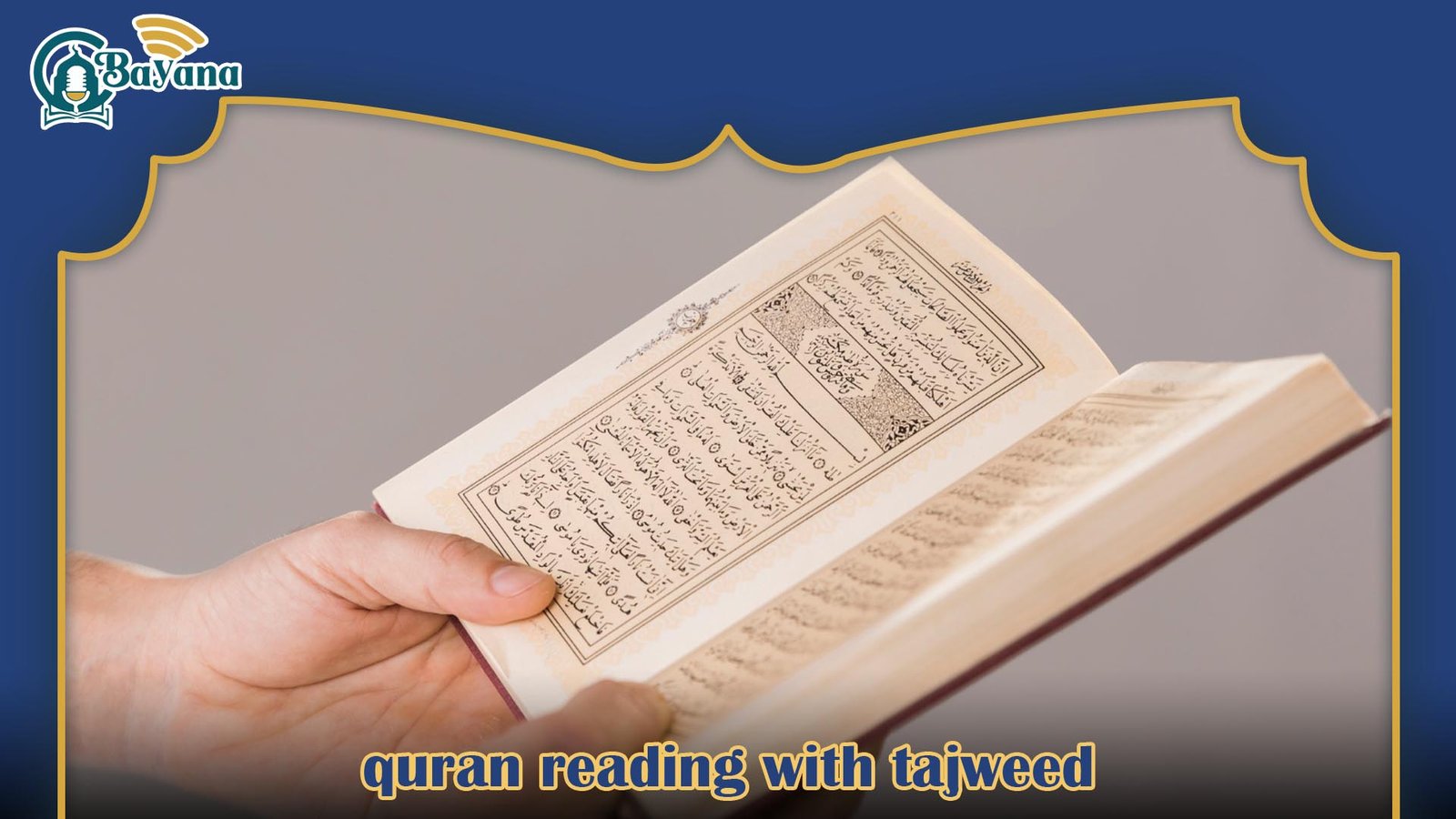Start your free trail Now

The Importance of Quran Reading with Tajweed 2025
Quran reading with Tajweed is a fundamental aspect of learning and reciting the Holy Quran, as it focuses on the correct pronunciation and articulation of each word according to established rules of recitation.
This practice not only enhances the clarity and beauty of the recitation but also ensures that the meanings of the verses are preserved and conveyed accurately.
By following the rules of Tajweed, readers develop a deeper spiritual connection and recite the Quran in the manner it was revealed.
Learning Tajweed

Developing proficiency in Quran reading with Tajweed is essential for anyone aiming to recite the Quran correctly and respectfully. Tajweed involves mastering the articulation and phonetics of each letter, ensuring that the recitation aligns with traditional, time-honored methods. To achieve this, learning directly from a qualified teacher is highly recommended. A skilled instructor can provide immediate feedback and correct subtle mistakes that might go unnoticed when practicing alone.
However, self-study can also be beneficial when supported with the right tools. Recording your recitation and comparing it with renowned Quran reciters—like Sheikh Mahmoud Khalil Al-Husary, Mohammed Ayoub, or Mishary Alafasy—can significantly improve your awareness of proper pronunciation and rhythm. These recitations serve as excellent references for applying Tajweed rules correctly.
For those unable to access in-person lessons, many mosques offer classes, and there are numerous online resources available. Platforms such as YouTube host a wide variety of Tajweed tutorials and step-by-step guides, making it easier than ever to start your journey in Quran reading with Tajweed. Consistent listening and practice are key to internalizing the rules and enhancing your recitation skills.
Meaning of Tajweed
Tajweed refers to the methodical and refined way of pronouncing the words of the Quran, aiming to preserve both their meaning and their beauty. The term itself comes from the Arabic root meaning “to make better” or “to enhance.” In the context of Quranic recitation, Tajweed involves a precise set of rules that govern how each letter and sound should be articulated, ensuring the Quran is read exactly as it was revealed.
Practicing Quran reading with Tajweed allows readers to connect more deeply with the message of the Quran, as it mirrors the way the Prophet Muhammad (peace be upon him) received and recited the verses under the guidance of the angel Jibreel. By observing these rules, one maintains the authenticity of the Quran and experiences its linguistic beauty in the most accurate form possible.
How to Learn Tajweed Online as a Beginner
Starting your journey in Quran reading with Tajweed as a beginner can be both exciting and rewarding, especially with the flexibility of online learning. The key to success lies in consistency, sincerity, and a clear intention to improve your recitation for the sake of Allah.
To begin, it’s important to establish a regular study routine and dedicate time specifically for Tajweed practice. Unlike casual reading, Tajweed requires focus and repeated application of rules, so patience and persistence are essential. A quiet space, a reliable internet connection, and a digital device like a smartphone, tablet, or computer are all you need to get started.
There are many online options available, from live interactive sessions with qualified teachers to structured pre-recorded video lessons. Depending on your schedule and learning style, you can choose the format that suits you best. Listening to skilled reciters and repeating after them is also an excellent way to reinforce correct pronunciation.
With the right mindset and tools, Quran reading with Tajweed can become a meaningful and manageable part of your daily routine—even from the comfort of your home.
Learn Tajweed Through Online Courses
For anyone looking to improve their Quran reading with Tajweed, online courses offer a flexible and personalized way to study, especially for those with different learning speeds and schedules. Because each learner has unique needs, online Tajweed programs are often structured in levels—designed to guide students from the basics to more advanced rules, depending on their starting point and goals.
1-Beginner Level – Foundations of Tajweed
This level is ideal for those just beginning their journey in Quran reading with Tajweed. Whether you’re a child or an adult, this stage focuses on the core elements—Arabic letter pronunciation, basic articulation techniques, and an introduction to the foundational rules of Tajweed. It lays the groundwork for accurate and respectful recitation.
2-Intermediate Level – Makharij and Sifat
For students who have a general understanding of recitation but need improvement in pronunciation and clarity, the intermediate level addresses key areas like Makharij (articulation points) and Sifat (attributes of letters). Learners are guided through refining their recitation, improving fluency while applying more detailed Tajweed rules.
3-Advanced Level – Mastering Tajweed
This stage is designed for learners who already recite the Quran confidently and accurately. The focus here is on mastering complex rules and perfecting delivery. It includes advanced applications of Tajweed, attention to rhythm, stops, and subtle phonetic distinctions that elevate the recitation to a high level of excellence.
Each level of these courses supports consistent progress, enabling students to deepen their understanding and application of Quran reading with Tajweed, while building a strong spiritual connection to the words of the Quran.
Benefits of Learning Quran Reading with Tajweed Online
Studying Quran reading with Tajweed brings immense spiritual and personal rewards. When choosing an online learning platform, it’s important to find one that offers tailored support and expert guidance to help you progress effectively. Here are some key advantages of enrolling in a structured online Tajweed program:
1-Customized Learning Experience:
Courses are designed to adapt to your individual pace and schedule, allowing you to learn comfortably and steadily. Flexible timing helps you balance your Quran studies with daily commitments, making consistent practice easier.
2-Experienced and Qualified Teachers:
Professional instructors with deep knowledge of Tajweed and Quranic sciences guide you throughout your journey. Their expertise ensures that you learn the correct pronunciation, rules, and nuances essential for proper recitation.
3-Trial Access to Evaluate Teaching Quality:
Many platforms offer free trial sessions so you can experience the teaching style and quality firsthand before committing. This helps build confidence that the program meets your expectations and learning needs.
4-Focused One-on-One Instruction:
Personalized attention is crucial, especially for beginners or those needing extra help. Individual lessons allow teachers to address specific challenges, provide detailed feedback, and customize lessons to your strengths and weaknesses.
5-Female Tutors Available:
For female learners, having access to female instructors can create a comfortable and supportive learning environment, promoting better engagement and understanding.
6-Certification and Community Support:
Upon completing the course, learners often receive a certificate that recognizes their achievement and dedication. Additionally, access to alumni networks and social groups encourages ongoing connection, motivation, and sharing of knowledge.
Through these benefits, engaging in Quran reading with Tajweed online becomes a meaningful, effective, and rewarding experience that nurtures both skill and faith.
The Importance and Ruling of Quran Reading with Tajweed
The practice of Quran reading with Tajweed holds a significant position in Islamic tradition, as it ensures the Quran is recited correctly and respectfully. Scholars throughout history have emphasized that applying the rules of Tajweed is not merely recommended but necessary. Failure to adhere to these rules can lead to errors that may alter the intended meaning of the Quranic text, which is considered a serious matter.
Islamic scholars have categorized recitation mistakes into two main types: clear errors that noticeably change meanings and more subtle mistakes that require a deeper understanding of Tajweed to identify.
Most scholars agree that avoiding clear mistakes in recitation is an individual obligation (Fard ‘Ayn) for anyone who memorizes or regularly recites the Quran. This means each person is responsible for ensuring their recitation does not distort the words or meanings.
On the other hand, mastering all the intricate rules of Tajweed to avoid subtle errors is seen as a communal obligation (Fard Kifayah).
This means that while not every individual must achieve perfection, the Muslim community as a whole must ensure that knowledgeable people preserve and teach these rules.
This practice honors the way the Quran was revealed and transmitted by the Prophet Muhammad (peace be upon him) and his companions.
Therefore, Quran reading with Tajweed is both a personal responsibility and a collective duty, essential for maintaining the purity and authenticity of the Quranic message for present and future generations.
What Are the Rules of Tajweed?
The term Tajweed, derived from the Arabic root meaning “to do well” or “to perfect,” refers to the precise and skillful way of reciting the Quran. In the context of Quran reading with Tajweed, it means giving every letter its due rights and characteristics during recitation. This involves correctly pronouncing each letter and applying the specific rules that govern how these letters behave in different contexts.
Each Arabic letter has inherent qualities that must be observed consistently, as well as additional characteristics that may apply only in certain situations. Respecting these features ensures the recitation remains authentic and true to how the Quran was originally revealed.
When the Quran was revealed, the rules of Tajweed were naturally practiced, as the Prophet Muhammad (peace be upon him) learned the recitation directly from the angel Gabriel, who taught him the proper ways to pronounce and recite the words.
Following these guidelines is therefore an essential part of honoring the Quran and maintaining its purity.Initially, Tajweed rules were not formally taught because the language and pronunciation were familiar to the people of that time. However, as Islam spread beyond Arabic-speaking communities and as spoken Arabic evolved over time, the need to study and preserve these rules became critical.
Today, even native Arabic speakers benefit from learning Tajweed to maintain the correct recitation.
Thus, Quran reading with Tajweed is a vital discipline that helps Muslims everywhere recite the Quran accurately, preserving its original beauty and meaning.
Helpful Tips for Learning Quran Reading with Tajweed
Mastering Quran reading with Tajweed requires guidance, practice, and the right resources. Here are some practical tips to help you on this journey:
1-Find a Qualified Teacher:
It is essential to learn Tajweed under the supervision of a knowledgeable instructor who can listen to your recitation and provide corrections. Tajweed involves precise mouth movements and sounds that cannot be fully grasped through books alone. A teacher’s feedback ensures you apply the rules accurately and helps you avoid common mistakes. Many communities offer Tajweed classes at local mosques or online.
2-Use a Tajweed Guidebook:
Select a clear and well-structured book that explains the rules of Tajweed step-by-step. Study the rules gradually, practicing each one with your teacher’s help. Books with diagrams demonstrating how to pronounce each letter can be especially useful, and there are options available in both Arabic and English.
3-Listen to Skilled Reciters:
Regularly listen to recordings of experienced Quran reciters who articulate clearly and at a moderate pace. Pay attention to how they apply Tajweed rules in their recitation. Try to imitate their pronunciation, tone, and rhythm to improve your own recitation and connect better with the meaning behind the words.
4-Use a Tajweed-Enhanced Quran:
Consider using a Mushaf that highlights Tajweed rules with color-coding or other visual cues. This can guide you while reading and help you remember the rules more easily. Some digital programs also provide interactive features to reinforce your learning.
5-Apply Rules to Memorized Surahs:
Consistently review and apply Tajweed to the portions of the Quran you have already memorized. Revisiting these sections helps reinforce correct pronunciation and prevents the formation of bad habits.
6-Practice Regularly:
Consistent practice and repetition are key to mastering Tajweed. The more you exercise your mouth and refine your recitation, the more natural it will become. Patience and dedication will bring steady progress.
By following these tips and committing to learning Quran reading with Tajweed, you ensure that your recitation remains true to the original revelation, deepening your spiritual connection and preserving the Quran’s beauty and meaning.
Reciting the Quran with Melodious Tone

The art of Quran reading with Tajweed includes not only correct pronunciation but also reciting in a slow, measured, and melodious manner.
The Prophet Muhammad (peace be upon him) exemplified this by reciting the Quran thoughtfully and rhythmically, never rushing through the verses.
He would pause appropriately at the end of each verse, allowing the meaning to resonate deeply.He encouraged believers to beautify their recitation by using a pleasant and melodious voice, as this enhances the spiritual impact of the words.
Sadly, many people today tend to recite the Quran too quickly and monotonously, missing the opportunity to connect emotionally and spiritually with the message.
Reciting the Quran with feeling and expression helps to convey its full depth—whether it be encouragement, warning, hope, or reverence.
When we engage with the Quran in this way, our recitation becomes more than just words; it becomes a heartfelt dialogue with the Divine.
Lack of confidence in reciting melodiously often stems from two main challenges: unfamiliarity with the rules of Tajweed and limited understanding of the Quran’s meanings.
By dedicating ourselves to learning Quran reading with Tajweed and striving to comprehend the language, we can overcome these barriers.
This will enable us to recite with both accuracy and heartfelt emotion, truly bringing the Quran’s message to life in our voices and hearts.
In conclusion, quran reading with tajweed is much more than just correct pronunciation; it is a profound way to deepen understanding, enhance spirituality, and convey the words of Allah in their most beautiful and authentic form.
Adhering to the rules of Tajweed helps preserve the Quran’s original message and elevates the experience of recitation for both the reader and the listener.
Therefore, dedicating oneself to learning and practicing quran reading with tajweed is a meaningful path toward drawing closer to Allah, appreciating the greatness of His words, and making the Quran a guiding light in our daily lives.



